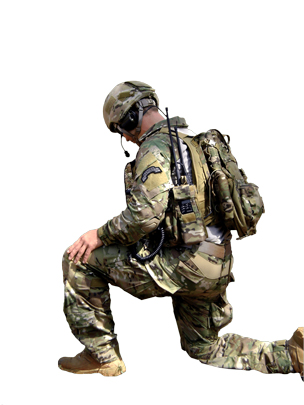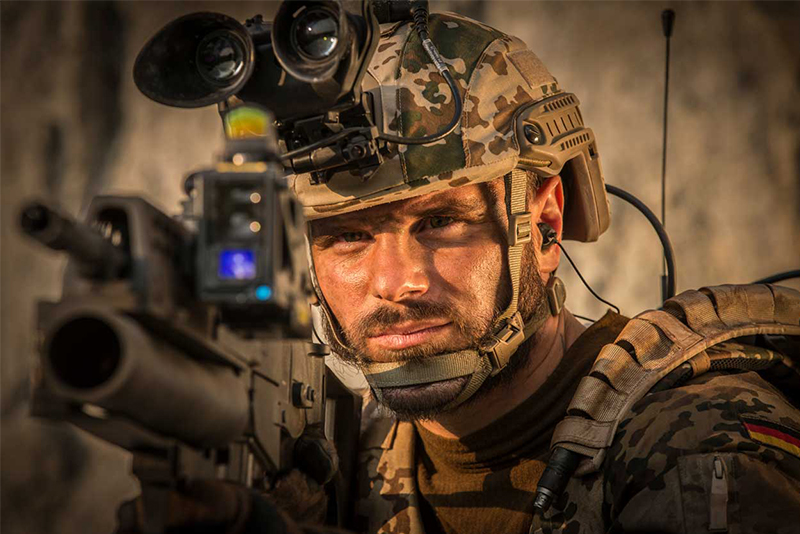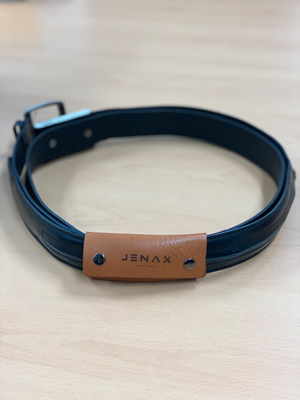
Methods of suppling power to soldiers in the field to support all of their personal electronic aides and being redefined – sometimes radically.
Power has become one of the most important consideration on today’s battlefields. The demands for electrical power have grown exponentially over the last decades. A particular challenge has been in portable power for the individual soldier and small units. The entire rifle squad in the 1970s had few items requiring batteries, possibility one short range radio and a night vision scope. Today each rifleman has these and more with the commensurate need to power them. Added to these are electronic sights, rangefinders, laptop computers, and communications gear. Plus these devices must be prepared to operate 24 hours over several days. Achieving the promised capabilities offered by these technologies is directly linked to solving the power dilemma.
Typically, soldiers tend to carry batteries for a 72-hour mission. This reflects both the importance of assuring their electronics and communications are available and also concern over reliable and timely resupply. With battery life lasting at most around eight hours, multiple batteries are needed over a mission’s duration, as well as a number of different battery types.
A United Kingdom Ministry of Defence (MoD) study found that on average each combat soldier carried around 26.5lbs (12kg) of batteries for a 36 hour patrol. A Canadian Army analysis found soldiers carried as many as 51 AA batteries and CR123 batteries for a 24 hour mission. Improving how power is provided to the soldier has the objective of both reducing this load as well as the quantity of batteries required.
Portable power is not just a military concern. It is also a limiting factor in many promising new commercial personal technologies. Just like the military these are seeking longer battery charges, faster and more possibilities for recharging, extending the overall battery life, reducing the size and weight of batteries, and improving safety. An additional area is in introducing alternate and/or complementary power sources.

One US Army focus has been on the individual soldier using a single carried power source connected to multiple devices. This Soldier Worn Integrated Power Equipment System (SWIPES) has been employed in combat. It is battery agnostic using standard military batteries carried in a rucksack or, for the infantry, a special conformal battery that is worn typically under body armour. At 2.2lbs (1kg) pounds) the 150wH Conformal Wearable Battery from Inventus Power is claimed to “provide power to all integrated equipment on an individual for 36 hours continuously or 24 hours continuously if transmitting data.” Its form fits to the wearer while a central hub and cable management system distributes power to the radio, personal display, night vision, and other worn devices. SWIPES allows more efficient use of power and eliminate the need to carry spare batteries. Power is provided to the radio through a smart charging cup seated in the bottom of the radio pouch. The radio battery remains intact but is provided a trickle charge assuring it is fully charged. Improvements to the approach have included SWIPES Lightweight Improved Releasable Plate Carrier (LIRPC) also developed by UEC-Electronics (ex-Electric Fuel Battery Corporation) that accommodates cable management inside the carrier shell reducing snag points, freeing up valuable MOLLE space and allowing easy access to power systems, headset cabling and concealable antenna.
Power Management
Marnie Blanshay director, Marketing for Galvion states that “energy efficiency at the individual level not only ensures power is available when it is needed but also has major impact on the energy consumption at the mission level”. The company has focused on solutions to efficiently manage power at the soldier and squad. Its Nerv Centr power supply and management products reduce weight and equipment volume while increasing energy redundancy. The objective is to offer an integrated system to store, deliver and harvest power with slim lithium batteries as well as the Squad Power Manager (SPM), Individual Power Manager (IPM) and customisable intelligent Adaptive Battery Charger (ABC). All are designed to draw from any source while both powering multiple devices and recharging batteries simultaneously from solar panels, vehicles, or line power.

Currently Lithium-Ion are the principle portable batteries. Its high energy density is its chief advantage. However, it has limitations on power duration, charging time, battery memory, overheating and both safety and disposal concerns. An alternative approach are Zinc Air batteries, a high-capacity, non rechargeable battery that can be used for direct power, as a portable charger, or in a hybrid with other power sources. Zinc-Air batteries had twice the energy density as Lithium’s at their stage of development in the early 2000s and are claimed to be inherently safe for storage, transportation, use and disposal. “Danger of fire and explosion is significantly lower than any other battery technology,” stated Felix Frisch, vice president Marketing and Sales at Epsilor Electric Fuel. “However as the price of lithium dropped and capacity increased the Zinc-air lost favour. Its wider scale use was also limited by the difficulty in recharging them.” However, researchers at the University of Sydney (Australia) and Nanyang Technological University (Singapore) have made progress in addressing this issue.
Another approach to addressing the soldier power limitations is providing for field recharging of the batteries. This allows changing out used batteries for ones that have been recharging thereby reducing the need to resupply batteries. Accomplishing this is simpler for mechanised forces or soldiers with access to a tactical vehicle. Acknowledging the benefits of this approach the French infantry combat system FÉLIN, developed by Safran Electronics, includes a vehicle integration kit which provides power to mounted soldiers’ systems. A number of other portable tactical battery chargers are also offered.
Israel’s Epsilon range of battery chargers include desk-mounted to portable ‘suitcase’ models, as well as tactical vehicle-mounted chargers. The company’s portable charging solutions can use any portable energy source including primary and reserve batteries, solar panels and fuel cells. Its MC-9001 Li–Ion Battery Charger auto senses the battery type to assure correct charge profile and is capable of charging up to 16 batteries in 14 hours. The US Army’s Universal Battery Charger (UBC) being manufactured by Thales offers simultaneous charging of multiple battery types. According to company literature its “UBC can accept not only radio and device batteries but also the SWIPES conformal batteries as well as having standard USB ports for charging phones and tablets.” It provides for fast charging of up to eight batteries simultaneously while indicating the state of charge and state of health of each. Weighing 6lbs (2.7kg) it is either man portable or vehicle mounted and has a built-in solar mode to draw power from a solar collector.
Bren-Tronics has provided its BTC-70100 Advanced battery charger to the US Marines. Under 22lbs (10kg) it charges eight BB-2590/U batteries charged in less than three hours and 16 Conformal BB-2525/U batteries in less than three and a half hours. It can draw power from AC (90-264Vac), DC (11-22Vdc, 46A), or Solar with MPPT. The company has also developed its BTK-70819-5 Soldier Portable Charger Lite (SPC) Kit w/Tan X90 Adapter a smaller, lighter 14.66lb (6.65kg) version of the SPC universal battery charger.
Solar charging systems for batteries have become both readily commercially available and affordable. They can be adapted to military BB and UB-series lithium ion, nickel metal hydride (NiMH), and NiCad batteries. Some use a Charge Cap, a ruggedised, sophisticated, solar powered battery charger that connects to the solar panel and battery, processing voltage and current from the panel. Use of smart charging technology prevents the battery over-charging, a LED bar graph indicates Time-to-Charge or Time-to-Discharge under steady state conditions, and a full set of LED lights that indicate the status of the system. Accessories broaden the end user’s applications, for example, recharging a PRC-152 handheld radio battery, or recharging the battery from the 24-volt DC NATO vehicle connector/port. In sunshine a system can typically recharge one BB2590 or a BB390 NiMH battery from empty to full in approximately three hours.
New changer approaches are not the only improvements being sought. Saft Groupe is looking at improving the rechargeable lithium-ion systems. A problem for soldiers in the field is their inability to determine the amount of a battery charge remaining. Rather than have it go dead in the middle of a mission they will replace them. Saft military Li-ion battery packs address this concern with protection charger fault features and an LED or LCD fuel gauge. Saft’s EcMC2 constant current / constant voltage charger family are also fit with State-Of-Charge (SOC) / State-Of-Health (SOH) indicators, SMBus communication or 2C communication.
Alternate Power
Research is underway to find more efficient battery solutions. One of these is the aqueous lithium-ion battery. Dr. Arthur von Wald Cresce, a materials engineer at the US Army Combat Capabilities Development Command’s Army Research Laboratory, has explained that this technology uses a lithium salt that is not heat-sensitive, allowing the battery to be stored at a much wider range of temperature and is also a non-flammable. Cresce and his team have created an aqueous lithium-ion battery prototype with a maximum potential of four volts – the same amount of energy found in typical lithium-ion batteries. These batteries could have less bulky protective packaging reducing their weight. It is hoped that the design can be refined for manufacture and fielded between 2026 and 2028.
Power Japan Plus has launched a new battery technology called Ryden dual carbon. It not only lasts longer than lithium but charges twenty times faster. The battery will last 3,000 charge cycles, and are safer with a lower chance of fire or explosion. These batteries can also be manufactured using the same factories as lithium batteries. This means it won’t require a huge investment by industry to change production. The carbon materials are also more sustainable and environmentally friendly than current alternatives.
The Spanish company Graphenano has introduced a graphene polymer battery. Dubbed Grabat, the batteries will have an energy density of 1,000 watt hours per kilogram (Wh/kg). In comparison, lithium batteries generally have an energy density of 180Wh/kg. Grabat also charge 33 times faster than a standard lithium ion battery.
Lithium-ion charging is limited by its tendency to heat-up. Researchers at WMG at the University of Warwick developed a precise test of Lithium-ion batteries’ internal temperatures and their electrodes potentials permitting safe charging up to five times faster. It has been tested on commercially available batteries. Dr Tazdin Amietszajew, who led this research, said: “This could push battery performance limits where rapid recharging is paramount”
Soldier Power

A number of industry initiatives offer the potential to further advance the way soldiers can be supplied with portable power more efficiently. Jenax in the Republic of Korea is developing J.Flex, a Flexible Lithium Polymer Battery. It is a power source that can fully bend and move without sacrificing power. This innovative flexible, solid-state, fast charging, rechargeable lithium-ion battery can be bent or rolled to any form. J.Flex can be as thin as 0.5mm (suitable for sensors), and as tiny as 20x20mm or as large as 200x200mm. These characteristics lend themselves to the incorporation of power cells directly into a soldier’s equipment. J.Flex could be used in a uniform or pack without hampering the soldier’s movement. At CES 2020 a consumer technologies expo in Las Vegas, EJ Shin, head of strategic planning at Jenax stated. “We’re putting batteries into locations where they couldn’t be before.” The company is looking at beginning production in 2020.
The Future
Finding solutions to individual soldier and small unit power is a critical factor in determining to what degree advanced electronics can realistically be employed by the soldier on the battlefield. Without sustainable power they are of little use while there are limits to how much more the soldier can carry. Without a power breakthrough the gains from electronic and computing could easily be curtailed.













